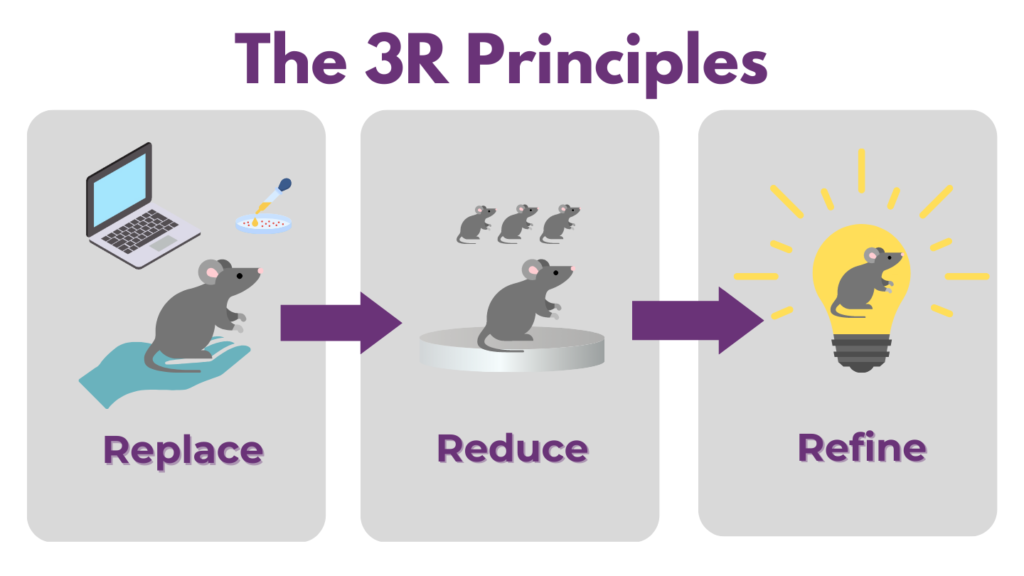Introduction : What are the 3R's?
What Are The 3R’s?
The use of laboratory animals for research, testing, and teaching is a privilege and not a right; with that privilege comes the responsibility to consider the 3R’s as they relate to animal welfare and their ethical treatment. Although these principles apply to all use of laboratory animals, this series will focus specifically on the use of animals in basic and preclinical research.
Join us over the coming weeks as we dive more into this topic.
Introduction
Basic research is focused on understanding the underlying mechanisms of disease, growth and development, and any number of other biological processes. As the processes studies relate more and more to human disease and development, basic research transitions more to preclinical research. Studies may be performed both in vitro, in vivo, ex vivo, or in silico, and new techniques and approaches are constantly being developed.
There are a number of commonly used species in preclinical research, most notably mice, rats, guinea pigs, rabbits, and non-human primates; but others may include hamsters, fish, flies, and pigs. As the use of laboratory animals increased steadily in the early 1900’s concern for their welfare also grew, leading to the publication of The Principles of Humane Experimental Technique by Russell and Burch in 1959. The research world recognized then, as it does now, that although replacing animals as research subjects is desirable, the knowledge that may be gained in an effort to better understand, diagnose, and treat human disease could, at times, only be gathered through the use of laboratory animals. However, they acknowledge that the use of any laboratory animal should be done with an eye towards applying the principles of the 3 R’s.
The 3 R’s
As was originally proposed by Russell and Burch, the 3R’s were defined as:
- Replacement– the substitution for conscious living higher animals of insentient material.
- Reduction – reduction in the number of animals used to obtain information of given amount and precision.
- Refinement – any decrease in the severity of inhumane procedures applied to those animals, which still have to be used.

The order in which the R’s were proposed had relevance, and it was their opinion that researchers must consider them in the order presented when discussing the use of laboratory animals in a study. Let’s look a little more closely at each of the principles.
Replacement
The first R, Replacement, seeks to find alternative methods that do not use live animals, or uses animals believed to have a significantly lower potential for pain perception.
There has been significant progress in the development of alternative methods, including in vitro testing on cell cultures, organoids, or bioprinted tissues; or in silico using computer simulations; that can provide results that are similar to those obtained from animal testing. These alternatives are often faster, cheaper, and more ethical than animal testing.
If animals must be used, then researchers should consider if a non-sentient alternative is available, such as an invertebrate, to replace the use of a more sentient vertebrate for example.
Reduction
The second R, Reduction, aims to minimize the number of animals used in a study while still obtaining statistically meaningful results; or in maximizing the information obtained from each animal. This can be achieved through various methods, including the use of better experimental design, sample size calculation, and statistical analysis methods. Additionally, the use of more advanced technologies, such as imaging techniques, can also reduce the number of animals needed in a study, and may increase the amount of information obtained from each animal. The goal of reduction is not only to reduce the number of animals used, but also to improve the quality and reliability of the results obtained.
Refinement
The third R, Refinement, focuses on minimizing any suffering or distress to animals used in experiments. This involves using less invasive procedures, providing proper care, and utilizing pain relief methods to reduce discomfort. The use of anesthesia and analgesia can help minimize the pain and distress associated with experimental procedures, while environmental enrichment and housing conditions can improve the overall well-being of animals used in research. These considerations are important not only during the time of the actual experiment, but from the time of the animal’s birth to the time of their death.
Discussion
Adhering to the 3Rs not only helps ensure that preclinical research is conducted in a humane and ethical manner, but it also helps to ensure the results are meaningful, reliable, and statistically relevant. When animals are subjected to unnecessary stress or suffering, this can affect their physiology and behavior, which can lead to unreliable results and a decrease in the overall quality of the research. Additionally, the use of alternatives and reduction in the number of animals used can also help reduce the overall cost and time required for a study, making research more efficient and effective. Researchers must, however, ensure that results have enough statistical significance at the completion of the study, to ensure that the work need not be repeated by themselves or others, thus ultimately using more animals in the end.
The principles of the 3Rs are not only important for ethical reasons, but they also play a crucial role in the advancement of scientific knowledge. By reducing the number of animals used and minimizing their suffering, we can ensure that the results obtained from animal research are accurate and reliable and can be used to improve human health and well-being.
Conclusion
The principles of Replacement, Reduction, and Refinement are essential in preclinical research, providing a framework for the ethical and responsible use of animals in scientific studies. By following the 3Rs, scientists can ensure that animal research is conducted in a humane and ethical manner, leading to more reliable and meaningful results.
Please join us in future weeks as we look more closely at each of the three R’s.
